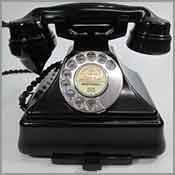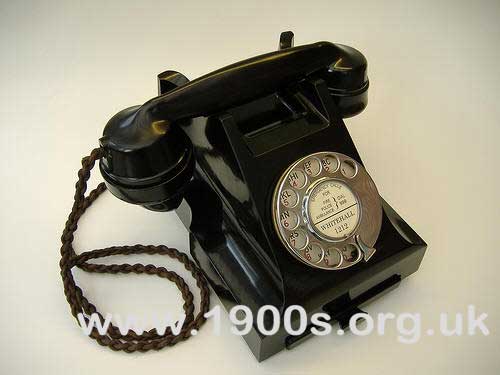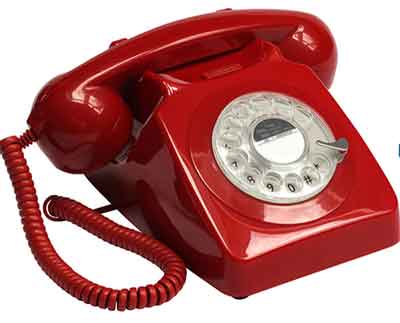Phones in the home 1940s-1960s UK

Recollections of using house phones in the 1940s, 50s and 60s: features that made them easier to use and more attractive over this time, but still with the disadvantage of lack of privacy in the home and having to share lines with neighbours on what were called party lines.
____
By the webmaster based on firsthand recollections and additional research with contributions from a former telephone engineer
In early 1940s wartime Britain, only a very few well-off families had phones at home - or were 'on the phone' as it was called. There were public telephones, and shops or businesses which were 'on the phone' might be encouraged in an emergency to let valued customers use their phones. There were of course no mobile phones.
House phones in the 1940s
There was no choice of supplier for phones, and everyone's 1940s phone was identical to everyone else's. These phones were supplied as part of the whole deal of 'being on the phone'. 'Candlestick' phones from before the war were still in use in some businesses and better-off families who had had phones for longer, but, as far as I know, were no longer supplied.
The 1940s phones were black and made of Bakelite, an early heavy plastic which chipped easily. They were in two usable parts, the handset and the base unit. They were always black.

Domestic phone from the early 1940s
Note the pull-out drawer in the base for a dialling code card and the typical braided fabric flex.
The handset was just the right size and shape for speaking directly into the mouthpiece end while holding the earpiece end to the ear. Although these handsets might look cumbersome compared with today's phones, they were comfortable to hold and had clear sound reproduction. Any lack of clarity was normally due to the line rather than the phone.
The base unit held the dial with its ten dial holes, each showing reference letters for the exchange and numbers underneath.
contributed by Ian Green for Milton Keynes Telephone Museum
There were two types of these phones around then. The older 200-series had a separate bell-set and 300-series which were the first UK phones to have an integrated bell.
The telephone cable
The base unit was connected to the handset and the wall socket with a rather ugly long brown cable, known as 'flex' - see the above photo. This consisted of three strands of wire, insulated with cotton or some other fabric and loosely platted together. It seemed second nature to fiddle with it while on the phone and to put one's fingers through it, separating out the three strands. It frayed dreadfully, but no-one seemed particularly concerned.
Ease of use over the earlier candlestick variety
These 1940s phones were easier to use than their predecessor candlestick phones which, being tall and narrow, were top-heavy. Although a few were wall mounted, users generally had to hold the tall base unit in one hand while holding the mouthpiece in the other. With two hands occupied, they couldn't easily take notes. The base units of the 1940s phones were short and wide, so that they stayed in position on a flat surface, so that only one hand was needed to use them, leaving the other free for taking notes.
House phones in the 1950s/60s
Phones which became standard some years later had much neater coiled, plastic-covered cable which extended when stretched. The design was also rather more streamlined, no longer as heavy, and colour was an option. Presumably the electronics was also updated but that is outside the scope of this website. There seemed little difference in general shape, ease of use, clarity of speech or how to make and receive a call, but they were lighter to use as modern plastics replaced bakelite.

A phone from the late 1950s or 1960s with the option of several colours and a neat, coiled cable, courtesy of Robbie Murray.
Note that the letters and numbers on the dial of the earlier phones are replaced by just numbers, as required by the new Subscriber Trunk Dialling STD.
Coloured phones and rental costs
contributed by Ian Jolly, one-time telephone engineer
The coloured UK phone was known at the time as a Modern Phone for which an extra rental charge was made of £2 per quarter. This was well towards the end of the 1960s. You had your choice of colour for the £2.
My parents kept their old-style phone way into the 1960s when the phone company exerted some pressure to make them change.
I seem to remember that other designs started to come in after the 1960s as options, but at a cost to customers.
Privacy and the location of the house phone
During the 1940s and into the 1960s, being on the phone was regarded as a luxury by ordinary families. Even then, there was normally only one phone in the house. It was set up in a fixed position which was invariably in the hall or passageway, to provide the easiest access from every room. Consequently there was no privacy from other members of the family.
To overcome the lack of privacy, my friends and I developed our own language for talking to each other privately. My mother could not help but overhear and it drove her to distraction. She called the language "hager-pager" which was really quite apt as it involved saying "ag" after every consonant and before every vowel. We actually became totally fluent at it.
House phones become portable
Some decades later domestic phones became more portable because they could be moved around and plugged into sockets around the house. These first plugs were robust affairs which worked on push-in and pull-out. Unfortunately I haven't been able to find a photo. Later they became smaller and worked on a squeeze principle.
Lines shared with neighbours - party lines
My father's work wanted him to get onto the phone as soon as he returned from the war. However, everything was in short supply then, so there was a waiting list for phones. Then when we did eventually get one, we had to share a line with neighbours.
How widespread were party lines?
contributed by Ian Jolly, one-time telephone engineer
Well into the 1970s from the end of WW2, it was a requirement for a residential subscriber to share a line if the GPO/PO so deemed. In fact I even remember coming across businesses on party lines.
Shared lines, also known as party lines, caused all sorts of problems. When we tried to use our phone we frequently found someone else talking on it.
The accepted polite thing to do was to immediately 'put the phone down' (ie return the handset to its cradle), and then wait a while before trying again. Similarly when we were talking on the phone, clicks on the line would indicate that a neighbour was trying to make a call and could therefore hear what we regarded as our private conversation. With polite neighbours, another click indicated that they had heard that we were talking and were no longer listening in, but it was disconcerting and it disrupted the flow of the call.
Crossed lines
It was not uncommon for two or more phone conversations to be heard at the same time. This was known as crossed lines and it was not only due to party lines. With the old analogue system of phone communication, it could be due to faulty wiring, damaged equipment, or just human error.
The end of party lines and crossed lines
Fortunately, in view of the problems with party lines, they began being phased out during the 1980s.
Crossed lines, though, do still occur although very rarely indeed with digital technology having taken over from manual.
| sources | webmaster | contact |
Text and images are copyright
If you can add anything to this page or provide a photo, please contact me.



